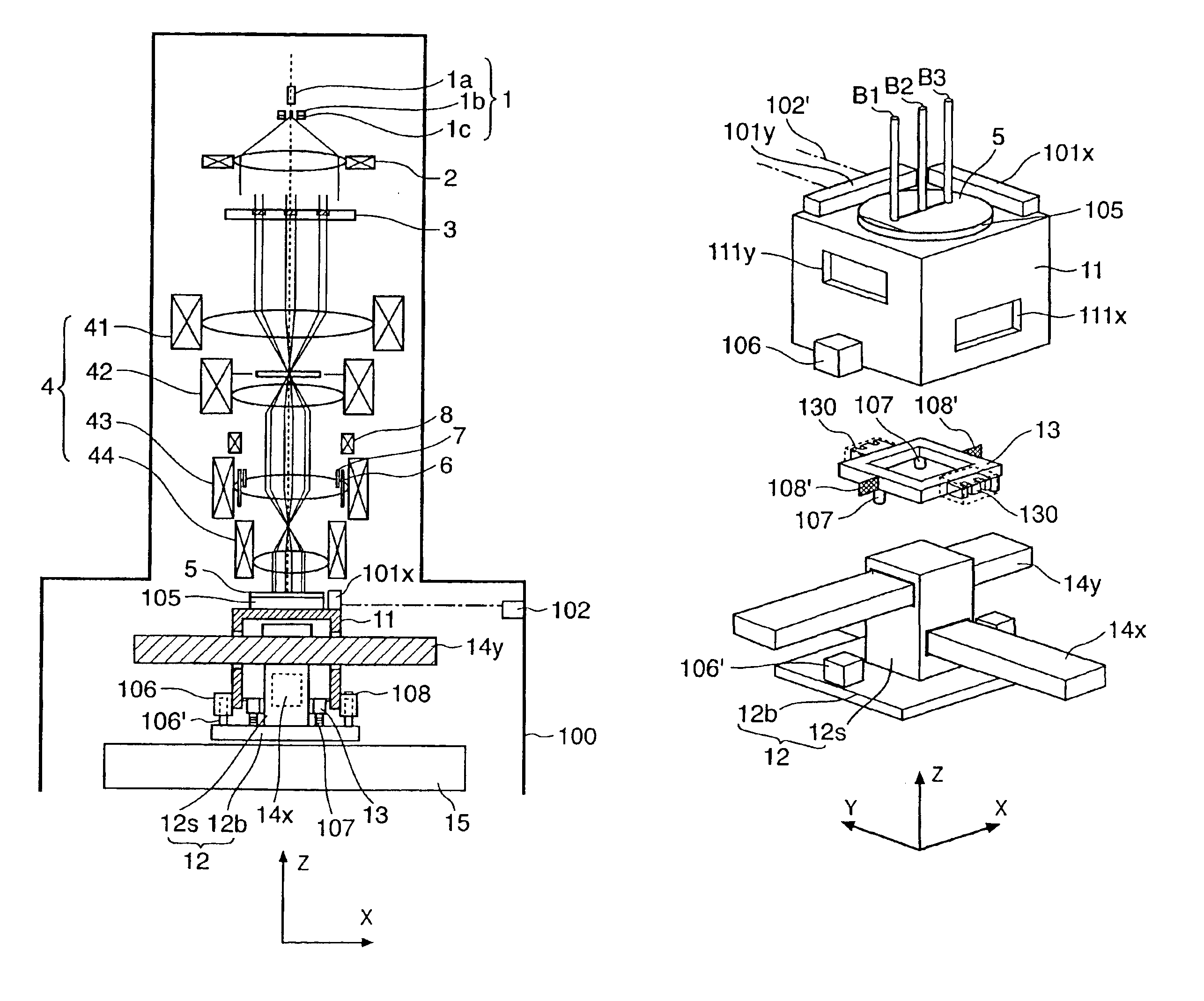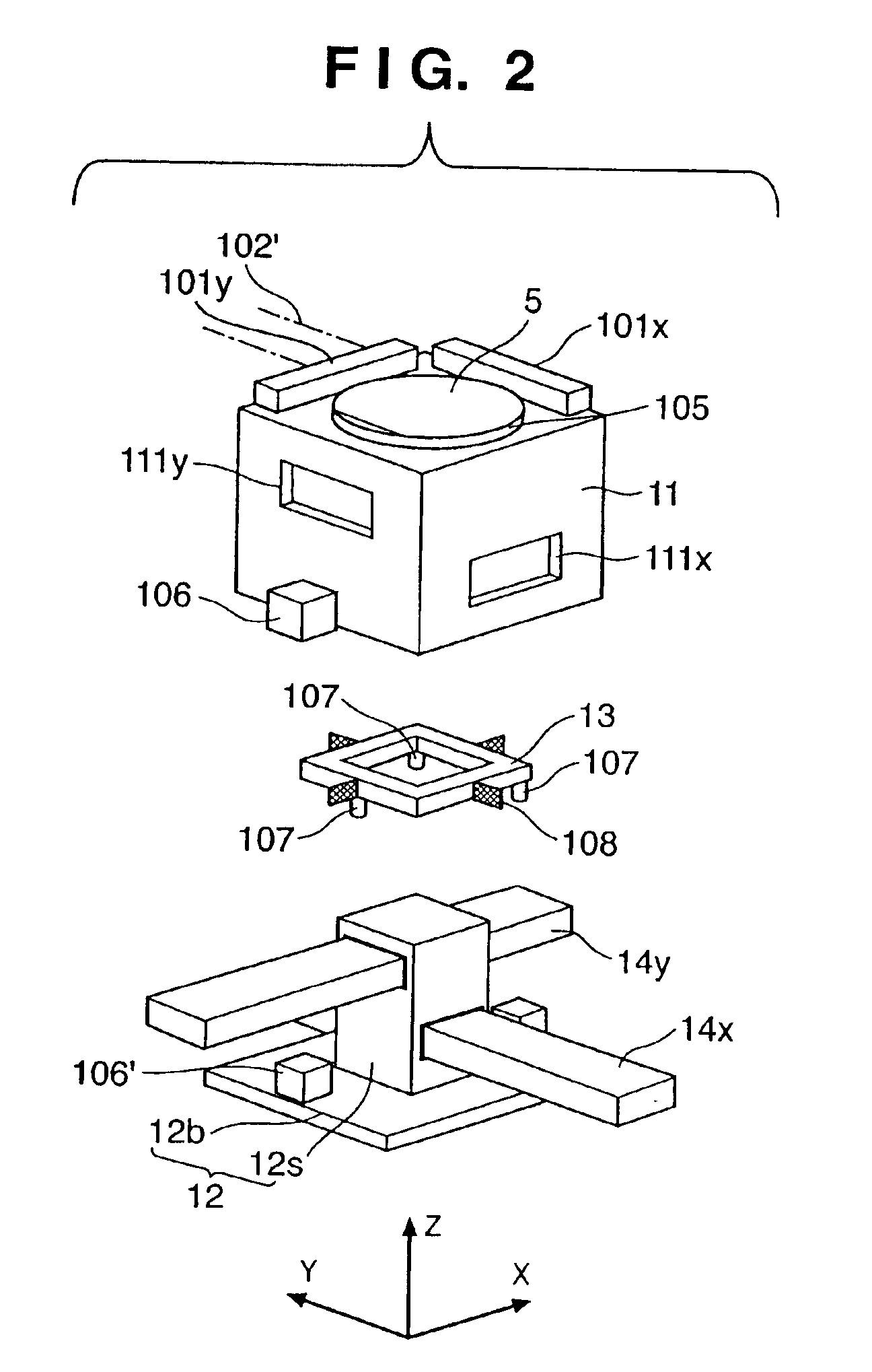Electron beam exposure apparatus and semiconductor device manufacturing method
- Summary
- Abstract
- Description
- Claims
- Application Information
AI Technical Summary
Benefits of technology
Problems solved by technology
Method used
Image
Examples
first embodiment
[First Embodiment]
[0045]FIG. 1 is a view showing an electron beam exposure apparatus according to a preferred embodiment of the present invention.
[0046]An electron gun 1 comprises a cathode 1a, grid 1b, and anode 1c. Electrons emitted from the cathode 1a form a crossover image between the grid 1b and anode 1c (this crossover image will be referred to as a light source hereinafter).
[0047]Electrons emitted from the light source form a substantially parallel electron beam through a condenser lens 2, whose front focal position is located at the light source position. The substantially parallel electron beam comes incident on an element electron optical system array 3. The element electron optical system array 3 is formed by arranging a plurality of element electron optical systems, each comprising a blanking electrode, an aperture, and an electron lens, in a direction perpendicular to the optical axis parallel to the Z-axis. The element electron optical system array 3 will be described ...
second embodiment
[Second Embodiment]
[0063]FIGS. 3A and 3B are views showing an electron beam exposure apparatus according to the second embodiment of the present invention.
[0064]In this embodiment, a plurality of electromagnetic actuators are combined. With this arrangement, a θZ tilt stage 11 can be driven with six degrees of freedom. As shown in FIG. 3A, the θZ tilt stage 11 has a cage structure surrounding a center slider 12 and has apertures 111x and 111y, through which an X movable guide 14x and a Y movable guide 14y extend. Six linear motor movable elements 120x, 120y, and 120z, which constitute parts of respective electromagnetic actuators, are fixed on the side surface of the θZ tilt stage 11. Linear motor stators 120x′, 120y′, and 120z′, which constitute the remainders of the respective electromagnetic actuators, are fixed on a bottom plate 12b to face the linear motor movable elements 120x, 120y, and 120z, respectively. As shown in FIG. 3B, the driving directions of the respective linear m...
third embodiment
[Third Embodiment]
[0066]FIGS. 4A and 4B are views showing an electron beam exposure apparatus according to the third embodiment of the present invention. The Y-axis direction in this embodiment is a direction perpendicular to the array direction of a plurality of electron beams (B1, B2, B3, . . . ). As shown in FIG. 4A, the θ measurement 102′ is preferably performed in a direction perpendicular to the array direction of the plurality of beams. A tilt frame 13 is supported on a bottom plate 12b of a center slider 12 through Z actuators 107 for driving a θZ tilt stage 11 in the Z direction. The tilt frame 13 is arranged to surround the center slider 12. As the Z actuators 107, piezoelectric devices with guides which are rigid in the X-Y plane may be used. The θZ tilt stage 11 is supported on the tilt frame 13 through θ free leaf springs 108 serving as a connecting member with a degree of freedom in only the θ direction (rotation direction about the Z-axis). The θ free leaf springs 108...
PUM
 Login to View More
Login to View More Abstract
Description
Claims
Application Information
 Login to View More
Login to View More - R&D
- Intellectual Property
- Life Sciences
- Materials
- Tech Scout
- Unparalleled Data Quality
- Higher Quality Content
- 60% Fewer Hallucinations
Browse by: Latest US Patents, China's latest patents, Technical Efficacy Thesaurus, Application Domain, Technology Topic, Popular Technical Reports.
© 2025 PatSnap. All rights reserved.Legal|Privacy policy|Modern Slavery Act Transparency Statement|Sitemap|About US| Contact US: help@patsnap.com



